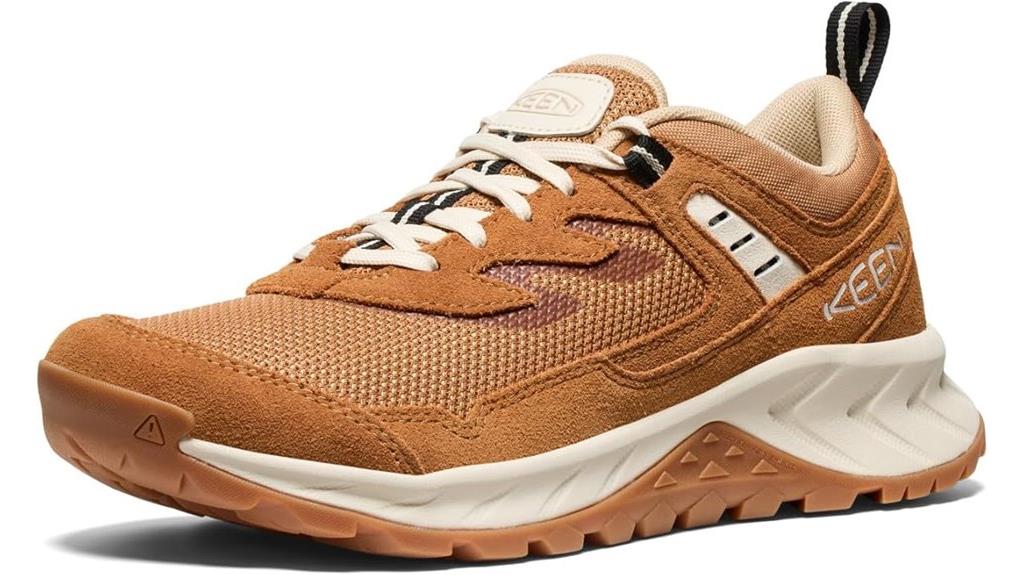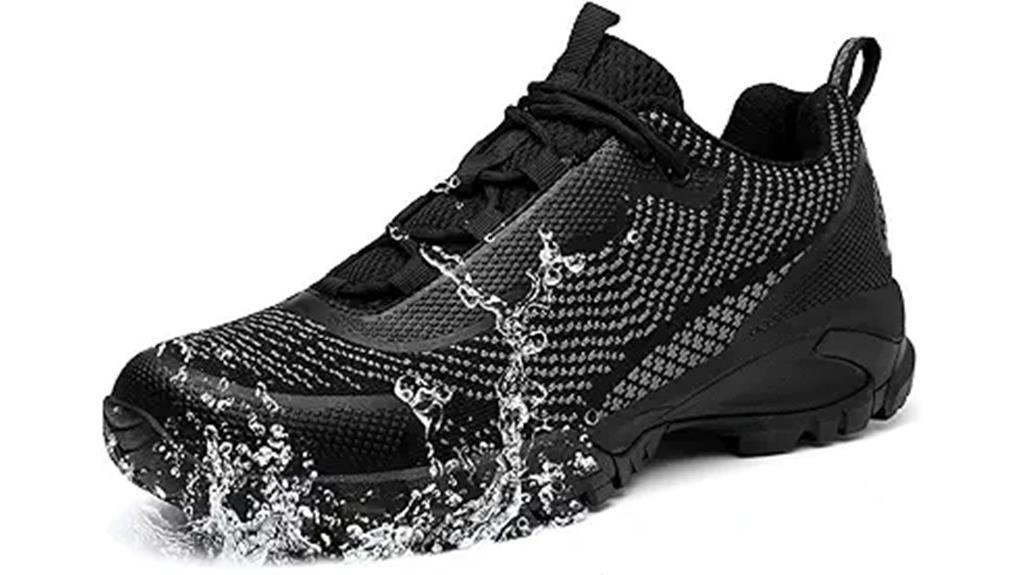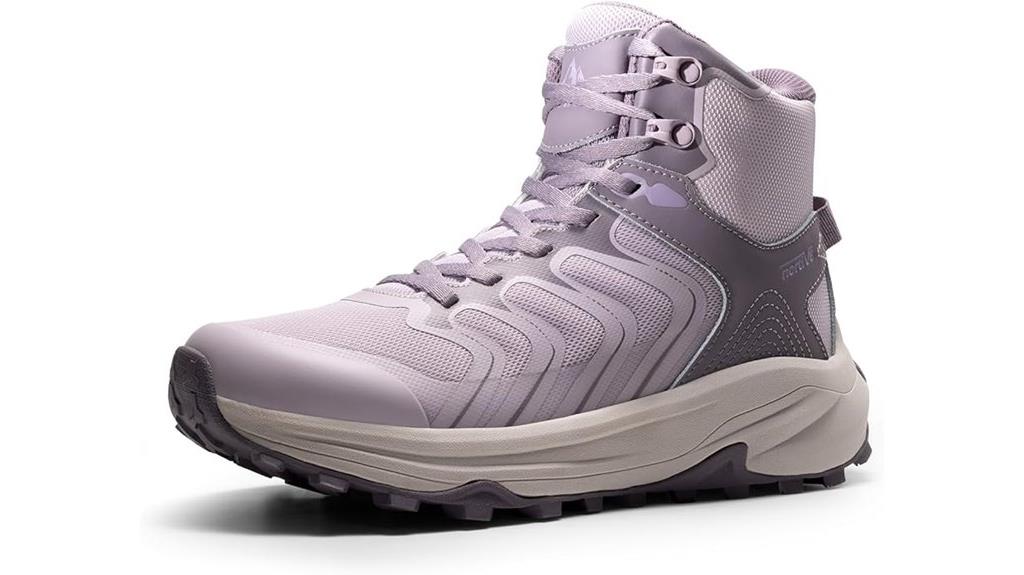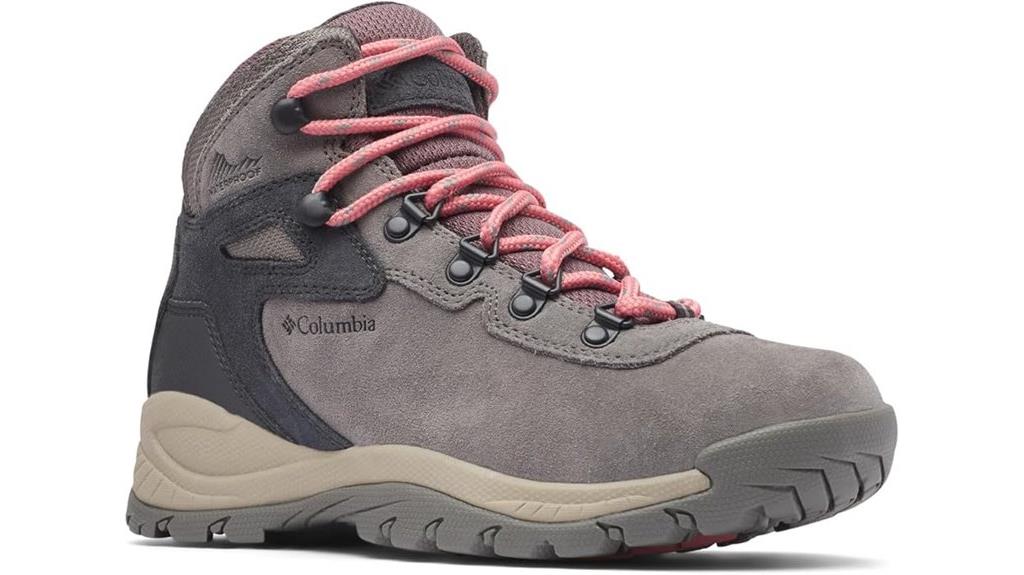Best Women Hiking Shoes
I’ve researched dozens of women’s hiking shoes and found the top performers share three critical features: waterproof construction, lightweight design under 1.5 pounds per pair, and aggressive traction with 4mm+ lug depth. The KEEN Hightrail Vent leads with superior durability and wide toe box comfort, while Merrell’s Moab 3 offers instant comfort with Gore-Tex protection. NORTIV 8 provides excellent arch support, though sizing runs inconsistent across brands requiring careful fit consideration for ideal performance.
We are supported by our audience. When you purchase through links on our site, we may earn an affiliate commission, at no extra cost for you. Learn more. Last update on 19th December 2025 / Images from Amazon Product Advertising API.
Notable Insights
- KEEN Women’s Hightrail Vent offers lightweight durability with water resistance and cushioned comfort for versatile hiking needs.
- Merrell Womens Moab 3 provides instant comfort and Gore-Tex waterproof options, making it a bestselling choice for hikers.
- NORTIV 8 Women’s Waterproof Hiking Boots deliver reliable waterproof protection with good arch support for wet conditions.
- Consider sizing carefully as many brands run slightly large or have inconsistencies requiring specific sizing chart consultation.
- Choose waterproof designs for wet environments or breathable options for hot climates based on your hiking conditions.
KEEN Women’s Hightrail Vent Lightweight Breathable Leather Hiking Shoes

Since day hikers need lightweight footwear that won’t sacrifice durability, the KEEN Women’s Hightrail Vent Low Hiking Shoes deliver both speed and longevity for single-day adventures. You’ll find water-resistant leather combined with breathable mesh that maintains comfort across varied terrain. The Contoured Fit design conforms to your foot shape for secure wear.
LuftCell technology provides cushioning that won’t compress over time, while the stability shank supports you on uneven ground. The wide toe box accommodates thicker socks without pinching. Breathable mesh keeps feet cool but requires periodic dirt removal. KEEN’s eco-conscious construction offers long-lasting performance, though arch support could be stronger for extended use.
Best For: Day hikers and casual outdoor enthusiasts who need lightweight, breathable footwear with water resistance for varied terrain and single-day adventures.
Pros:
- Lightweight design with LuftCell cushioning technology that maintains support over time
- Water-resistant leather combined with breathable mesh for comfort in diverse conditions
- Wide toe box and Contoured Fit design accommodates different foot shapes and thicker socks
Cons:
- Mesh material traps dirt and requires regular cleaning maintenance
- Limited arch support may not be sufficient for extended hiking or heavy-duty use
- Sizing appears larger on feet compared to traditional sneakers
Hiking Shoes Women Waterproof Lightweight for Outdoor Activities

Women’s waterproof lightweight hiking shoes excel at three critical performance areas that matter most for outdoor enthusiasts: immediate comfort without break-in periods, reliable weather protection, and reduced pack weight for extended adventures.
You’ll experience zero break-in requirements with these shoes. Hikers complete 19-mile strenuous trails without discomfort issues. The lightweight construction reduces fatigue during long treks while maintaining structural integrity comparable to premium brands.
Sizing runs inconsistent across models. You may encounter shoes running one to one-and-a-half sizes large or short. High-cut backs can cause ankle friction and potential blistering.
The sole construction delivers adequate support for light trail applications. Waterproof membranes provide moisture protection, though testing opportunities remain limited due to sizing problems.
You’ll find budget-friendly pricing without sacrificing style or core performance features compared to established brand alternatives.
Best For: Budget-conscious hikers seeking lightweight, waterproof shoes for light trail walks who prioritize immediate comfort and don’t mind potential sizing challenges.
Pros:
- No break-in period required with high comfort levels for long-distance hiking
- Lightweight construction reduces fatigue while maintaining durability comparable to premium brands
- Budget-friendly pricing with attractive styling and waterproof protection
Cons:
- Inconsistent sizing with shoes running 1-1.5 sizes too large or small across models
- High-cut backs may cause ankle friction and potential blistering
- Limited real-world waterproof testing due to widespread sizing issues
NORTIV 8 Women’s Waterproof Hiking Boots with Arch Support

Budget-conscious hikers seeking reliable waterproof protection will find the NORTIV 8 Women’s Waterproof Hiking Boots deliver exceptional value without compromising essential trail features. You’ll appreciate the khaki-grey design that shifts seamlessly from trail to casual wear. The lightweight construction includes substantial arch support and cushioning for all-day comfort.
Waterproof membranes keep feet dry during stream crossings and light precipitation. The outsole provides adequate traction on varied terrain with grooved patterns that add half-inch height. You’ll find these boots versatile enough for hiking, yard work, and daily activities.
However, you may experience initial stiffness and uneven toe box padding. Some users report fit variations between feet, potentially requiring aftermarket insoles for best comfort.
Best For: Budget-conscious hikers and individuals seeking versatile waterproof boots for trail activities, daily wear, and outdoor work who prioritize value and don’t mind a potential break-in period.
Pros:
- Excellent waterproof protection with reliable performance during stream crossings and light rain
- Lightweight construction with substantial arch support and cushioning for all-day comfort
- Versatile design that transitions well from hiking trails to casual everyday wear
Cons:
- Initial stiffness and uneven toe box padding may cause discomfort during break-in period
- Fit variations between left and right feet reported by some users
- May require aftermarket insoles for optimal comfort, especially for narrow-footed individuals
Merrell Womens Moab 3 Shoe

Over 20 million hikers have chosen the Merrell Moab 3 as their go-to footwear, making it the bestselling hiking shoe for more than a decade. You’ll find this third iteration delivers enhanced performance through its Kinetic Fit ADVANCED insole and upgraded Vibram® outsole. The shoe fits true to size for most users, though wide-foot hikers often size down half a size.
You won’t need a break-in period with these shoes. The cushioned midsole provides excellent support across varied terrain, from loose gravel to wet surfaces. Durability testing shows typical replacement cycles of six months under heavy use. The Gore-Tex waterproof option maintains breathability while keeping feet dry during extended hikes.
Best For: Hikers seeking a proven, comfortable shoe that performs well across diverse terrains without requiring a break-in period.
Pros:
- No break-in period required with immediate comfort out of the box
- Excellent grip on varied terrain including loose gravel and wet surfaces
- Durable construction with breathable yet waterproof Gore-Tex option
Cons:
- Replacement needed approximately every six months under heavy use
- Lacing system requires adjustments during use
- Sizing inconsistencies, particularly with wide options requiring size adjustments
Columbia Womens Newton Ridge Plus Waterproof Amped Hiking Boot

The Columbia Women’s Newton Ridge Plus Waterproof Amped Hiking Boot excels as the top choice for hikers who prioritize ankle support and waterproof protection on challenging terrain. You’ll appreciate the seam-sealed waterproof construction that keeps feet dry in wet conditions. The full grain leather and suede upper provides durability, while the mesh tongue enhances breathability. These boots deliver exceptional ankle stability on rocky paths and steep inclines without slipping or rolling. You can hike 6-8 miles comfortably across various terrains. The boots fit true-to-size, though you might want a half-size up for thick socks. Wide feet adapt well to this design.
Best For: Hikers who need reliable waterproof protection and ankle support for challenging terrain, rocky paths, and wet conditions during moderate to long-distance hikes.
Pros:
- Excellent waterproof seam-sealed construction keeps feet dry in wet conditions
- Superior ankle support and stability prevents slipping or rolling on difficult terrain
- Comfortable for extended wear during 6-8 mile hikes across various terrains
Cons:
- Some customers received products that appeared slightly worn or dirty upon arrival
- May require additional insoles for users with flat feet
- Sizing can be confusing between half and full sizes for some buyers
NORTIV 8 Women’s Lightweight Hiking Shoes with Quick Laces

Looking for hiking shoes that won’t slow you down when you’re dealing with mobility challenges or simply want hassle-free footwear? NORTIV 8’s quick-lace system eliminates traditional tying methods, delivering convenience when you need it most.
These lightweight hiking shoes fit true to size across the entire range. Size 7M and 7W accommodate standard feet perfectly, while size 8.5 wide provides comfortable room for broader feet. You’ll experience consistent fit regardless of terrain demands.
The slip-resistant outsole grips effectively on rocky surfaces and muddy trails. Users report zero blister formation during break-in periods, indicating superior comfort engineering. However, the fabric construction isn’t waterproof—expect water penetration in wet conditions despite otherwise solid hiking performance.
Best For: Women seeking lightweight, comfortable hiking shoes with convenient quick-lace systems who prioritize ease of use and reliable traction over waterproof protection.
Pros:
- Quick-lace system provides hassle-free convenience, especially beneficial for those with mobility challenges
- True-to-size fit across all sizes with comfortable wide options available
- Excellent slip resistance and grip on rocky and muddy terrain with no break-in blisters
Cons:
- Not waterproof – fabric allows water penetration in wet conditions
- Limited weather protection compared to other hiking shoe options
- May not be suitable for hiking in consistently wet or rainy environments
Merrell Womens Speed Strike 2 Hiking Shoe

Merrell’s Speed Strike 2 delivers immediate comfort for hikers who refuse to endure break-in periods, featuring durable outdoor mesh uppers and a sticky trail outsole designed for diverse terrain challenges. You’ll find excellent traction across wet surfaces and rocky trails. The wider toe box accommodates flat feet with moderate arch support included.
Sizing runs slightly large, though comfort remains exceptional. Years of durability testing by users confirms construction quality. However, quality control inconsistencies exist—some customers receive used pairs with dirt, scratches, or misaligned insoles. Beautiful color options enhance visual appeal while maintaining functional performance standards for outdoor activities.
Best For: Hikers with flat feet who want immediate comfort without a break-in period and need reliable traction on diverse terrain including wet surfaces.
Pros:
- Exceptional comfort straight out of the box with wider toe box design
- Excellent traction and durability for various outdoor terrains over years of use
- Beautiful design with appealing color options that combine style and functionality
Cons:
- Sizing tends to run slightly large which may require ordering a smaller size
- Quality control issues with some customers receiving used or damaged pairs
- Return process can be frustrating when dealing with defective products
Knixmax Women’s Lightweight Non-Slip Hiking Shoes

Budget-conscious hikers who refuse to compromise on performance will find exceptional value in the Knixmax Women’s Lightweight Non-Slip Hiking Shoes. You’ll get dual removable insoles and a quick-lace system at an affordable price point. The suede leather and mesh construction weighs just 0.78 kg while delivering breathable comfort.
The aggressive lug pattern outsole provides reliable traction on gravel and dirt trails. You’ll appreciate the roomy toe box design that accommodates wider feet comfortably. These shoes run true to size, though some users recommend sizing up.
The breathable lining keeps your feet dry during extended hikes. You can easily adjust the fit using the one-pull lacing system. However, you might need custom insoles if you have plantar fasciitis or require additional arch support.
Best For: Budget-conscious hikers and outdoor enthusiasts who need versatile, lightweight shoes for hiking, walking, and light trekking on various terrains.
Pros:
- Dual removable insoles and quick-lace system provide excellent value and convenience at an affordable price point
- Lightweight construction (0.78 kg) with breathable suede leather and mesh materials keeps feet comfortable and dry
- Aggressive lug pattern outsole delivers reliable traction on gravel, dirt trails, and mixed terrain
Cons:
- Default insoles may lack adequate arch support, requiring custom replacements for users with plantar fasciitis or foot conditions
- Color bleeding reported on damp surfaces, requiring caution during wet conditions
- Limited color options with only black available
JishinGal Women Outdoor Mesh Trail Shoes for Hiking & Walking

The JishinGal Women Outdoor Mesh Trail Shoes excel as summer hiking footwear for budget-minded adventurers who prioritize breathability over long-term durability. You’ll appreciate the mesh construction that provides excellent ventilation during hot-weather activities. The lightweight design reduces foot fatigue on moderate trails.
You should expect roughly three months of regular use before sole deterioration becomes apparent. The ridged sole pattern creates uneven contact points on hard surfaces, potentially causing discomfort during extended wear. You’ll need to size up if you have wider feet, as the instep runs narrow.
These shoes lack water resistance due to their mesh design. You’ll experience poor traction on wet surfaces, making them unsuitable for rainy conditions or slippery terrain.
Best For: Budget-conscious hikers who need lightweight, breathable footwear for hot-weather day hikes on dry trails and don’t mind replacing shoes every few months.
Pros:
- Excellent ventilation through mesh construction keeps feet cool during summer activities
- Lightweight design reduces foot fatigue on moderate hiking trails
- Attractive aesthetics with appealing color options and suede-like materials
Cons:
- Poor durability with soles wearing out and developing holes after approximately three months
- No water resistance and poor traction on wet surfaces create safety concerns
- Narrow fit across the instep requires sizing up, especially for those with wider feet
Factors to Consider When Choosing Women Hiking Shoes
I’ll guide you through the essential factors that determine whether a hiking shoe will serve you well on the trail. Your choice must balance five critical elements: proper fit and sizing, comfort with adequate support, the trade-off between waterproofing and breathability, terrain-appropriate traction systems, and the relationship between weight and long-term durability. Each factor directly impacts your performance, safety, and enjoyment during hiking activities.
Fit and Sizing
How can you guarantee your hiking shoes actually fit when brands consistently run different sizes? I recommend trying shoes with your actual hiking socks, as this notably impacts overall comfort. Many users discover sizing discrepancies where shoes run small or large compared to standard measurements.
Focus on width alongside length measurements. A wide toe box accommodates different foot shapes and thicker socks, reducing discomfort during extended hikes. Some brands fit true to size, while others require adjusting up or down half a size based on your foot conditions.
Consider your entire foot profile rather than just length. Many hiking shoes offer varying width options to accommodate wider feet. This thorough approach guarantees proper fit across all pressure points, preventing hotspots and blisters on challenging terrain.
Comfort and Support
Getting the right fit sets the foundation, but comfort and support features determine how your feet feel after miles on the trail. I prioritize proper cushioning systems like LuftCell technology and specialized insoles that reduce fatigue during extended hikes. A wide toe box allows natural foot movement and accommodates thicker hiking socks, preventing painful blisters on uneven terrain.
Secure fit conforming to your foot shape minimizes slippage while providing essential stability across varied surfaces. Lightweight construction reduces strain without compromising durability. Arch support proves vital for comfort, alleviating pressure points and improving posture. This becomes especially important if you have flat feet or high arches. Quality arch support systems distribute weight evenly, preventing discomfort that builds over long distances and challenging terrain conditions.
Waterproof Vs Breathability
When selecting women’s hiking shoes, the waterproof versus breathability decision represents one of the most critical trade-offs you’ll face. Waterproof designs utilize Gore-Tex membranes or treated leather with sealed seams to block moisture entry. These materials create barriers that can restrict airflow, potentially causing overheating during intense activity.
Breathable shoes incorporate mesh panels that promote air circulation, making them ideal for hot climates. However, they sacrifice complete water resistance, allowing moisture penetration in wet conditions.
I recommend prioritizing waterproofing for rainy environments and muddy terrain. Choose breathable options for desert hiking and summer conditions. Some manufacturers now offer hybrid designs that balance water resistance with ventilation features, providing versatility across varying weather patterns and terrain types.
Terrain and Traction
Your hiking shoe’s traction system must match the specific terrain you’ll encounter, as the wrong outsole design can turn a pleasant hike into a dangerous slip-and-fall scenario. Rocky and technical trails demand aggressive lug patterns with deep, widely-spaced treads that bite into uneven surfaces. I recommend 4-5mm lug depth for maximum grip on loose rocks and steep ascents.
Smooth or paved trails work best with flatter outsoles that maximize ground contact. These designs distribute weight evenly and reduce rolling resistance. For muddy conditions, look for self-cleaning lug patterns that shed debris automatically.
Sole rigidity matters considerably. Stiff soles protect against sharp rocks but reduce flexibility. Flexible soles offer comfort on gentle terrain but compromise protection. Consider your primary hiking environment when weighing these trade-offs.
Weight and Durability
Every ounce matters when you’re carrying gear mile after mile, making the weight-to-durability ratio the most critical balance in hiking shoe selection. Lightweight models typically weigh 0.5 to 1.5 pounds per pair, noticeably reducing leg fatigue during extended hikes. However, don’t sacrifice longevity for lightness.
High-quality materials prove essential for durability. Reinforced leather uppers, strengthened mesh panels, and robust rubber outsoles withstand rough terrain and extended wear. Well-constructed shoes last several years with regular use in challenging conditions.
I’ve found that many lightweight options prioritize breathability through mesh construction, while durable models often feature waterproof membranes. This creates different performance profiles for various conditions. Quality lightweight shoes deliver excellent traction through advanced tread patterns and grip-enhancing compounds, proving that reduced weight doesn’t mean compromised safety on uneven terrain.
Break-in Period Requirements
Breaking in hiking shoes can make or break your trail experience, yet modern shoe technology has dramatically reduced this traditional concern. Many contemporary women’s hiking shoes feature cushioned insoles and flexible designs that eliminate break-in periods entirely. I recommend looking for models with wide toe boxes and lightweight materials that conform immediately to your foot shape.
Shoes constructed with softer components and ergonomic designs adapt quickly without causing blisters or discomfort. You can tackle strenuous trails right away with supportive models that provide excellent fit from day one. The key lies in evaluating construction materials—softer synthetics and mesh uppers typically require zero adjustment time compared to rigid leather boots that demand weeks of gradual wear.
Price and Value
Most women’s hiking shoes range from $50 for basic models to over $200 for premium options, with this price spread directly reflecting differences in construction quality, advanced features, and brand positioning. I recommend calculating cost-per-wear to determine true value. A $180 pair lasting three years with weekly use costs roughly $1.15 per hike, while $60 shoes replaced annually cost $1.25 per hike.
Budget models often compromise on waterproofing, traction compounds, and breathable membranes. You’ll likely need aftermarket insoles, adding $20-40 to your total cost. Premium shoes integrate Gore-Tex waterproofing, Vibram outsoles, and ergonomic footbeds from manufacturing. Quality construction prevents blisters and foot fatigue, reducing injury risk. Higher-priced shoes typically offer better long-term comfort and performance across varied terrains and weather conditions.
On a final note
I’ve evaluated these eight top-rated women’s hiking shoes based on waterproofing, breathability, traction, and durability metrics. Each model offers distinct advantages: KEEN’s leather construction provides longevity, while Merrell’s proven outsole compounds deliver superior grip. Consider your specific terrain requirements, foot width, and seasonal conditions when selecting. Don’t compromise on proper fit—your feet will thank you after those challenging 10-mile days on rocky trails.



